You have a bold idea. You can build the tech. But is it the right problem? The fastest way to know is to sit with real users and listen. Not to sell. To learn. Customer interviews turn guesses into facts. They show what hurts, what matters, and what people will do next. When done well, they give you clean proof you can use in product, pricing, go-to-market, and even patents. They also make your pitch stronger because you are not waving hands—you are showing signals from the field.
This guide shows you how to plan, run, and turn interviews into validation data you can trust. We’ll keep it simple and tactical. You’ll learn what to ask, how to capture the words that count, how to code the notes, and how to turn patterns into actions. You’ll also see how this data shapes your IP story so your edge is clear and defensible from day one.
If you want a partner to help you turn interview insights into protected methods and a fundable story, Tran.vc invests up to $50,000 in in-kind patent and IP services for AI, robotics, and deep tech teams. Apply anytime at https://www.tran.vc/apply-now-form/.
Set the Goal of Each Interview

Before you talk to anyone, be clear on why you are talking. A focused goal keeps the call short and useful. It also makes your notes easy to read later. You want answers that guide a real choice, not a nice chat that goes nowhere.
Define the decision you need to make
You are not collecting trivia. You are making a call. Say the decision out loud in one clean line. It could be, “Should we build auto-labeling first?” or “Should we price per device or per site?” When the decision is sharp, your questions get sharp too.
Keep the scope small. One decision per interview is enough. If you chase five topics, you will skim each one and learn little. A narrow goal lets you dig into real moments, not vague feelings. Depth beats width at this stage.
Write the decision at the top of your doc. Read it before the call starts. If the talk drifts, check the line and bring it back. This tiny habit turns random notes into validation data you can trust.
Choose the user segment on purpose
Pick one role and one setting. If you build for a plant, say “line supervisor on a two-shift line that runs metal parts.” If you build for a lab, say “research associate who prepares samples each morning.” Clear roles reduce noise and make patterns visible fast.
Do not mix wildly different users in the same batch. A CTO and a technician live different days. Their pain and pace will not match. When you keep segments clean, your findings point to a target customer you can describe in plain words.
If you are unsure which segment is right, plan two small batches. Run five calls for each. Compare the signals side by side. Pick the one with sharper pain and faster steps to value. That becomes your wedge.
Frame the outcome you want
Decide what proof would move your team. It could be a number, like “three out of five run this task daily.” It could be a behavior, like “they pay for a small pilot next week.” When you name the outcome, you know what to listen for and what to test next.
Share the outcome with your team before you start. Ask if this proof would change a roadmap, a price, or a pitch. If the answer is no, adjust the outcome. You are not doing research for fun. You are buying speed and clarity.
At the end of each call, check your notes against the outcome. If you did not get what you need, ask one more direct question. The last minute is often the most honest minute.
Find and Recruit the Right People

Good interviews start with the right people. You want folks who live the problem, have a stake in the fix, and can act. Five strong voices beat twenty soft ones. Aim for truth, not volume.
Go where the work happens
Reach out through channels that real users trust. Ask your friends for a warm intro to line managers, lab leads, or ops folks. Visit the floor if you can. Join the small forums where they trade tips, not the big ones full of ads.
When you write, keep it short and specific. Name the task you want to discuss and the time you need. Use plain words that sound like their day. People say yes when they feel you respect their time and their world.
Offer a simple thank-you. A gift card, a donation, or early access is fine. Make it easy to accept. Do not ask for a long form. Do not make them jump hoops. Smooth paths bring better people.
Screen for fit without scaring people off
Ask two or three quick questions before the call. Focus on behavior, not title. “How often do you do X?” “What tool do you use today?” “What breaks most?” These answers tell you if they live the problem you care about.
Skip folks who are too far from the work. Champions are nice, but hands-on users carry the best truth. If the person delegates the task to others, ask to include the doer on the call.
Keep a simple tracker with who you asked, who replied, and who booked. This small system keeps the pace steady. It also shows you which channels bring the best fit, so you can double down there.
Set clear expectations
Tell people what the call is and what it is not. Say you are not selling. Say you will ask about their day, their pain, and what they tried. Promise to keep it short and private. Then keep that promise.
Share the agenda in one line and the time box in bold. “25 minutes on how you handle changeovers.” When the invite looks clean, people show up ready to talk. Trust starts before the call begins.
After booking, send a brief note with two questions to think about. Keep them open and simple. This warms up the session and saves time in the first five minutes.
Craft Questions That Surface Truth

The best questions are plain, grounded, and about the past. They pull out real stories, not dreams. They help you code notes later because the answers tie to time, place, and result.
Ask about the last time, not the next time
“Tell me about the last time this failed” is a strong start. It takes people to a real moment with facts you can check. You will hear the steps, the blockers, and the cost. You will spot the workarounds and the hidden tools.
Avoid hypotheticals. “Would you use a tool that…” invites polite fiction. People want to be nice. They guess. Guesses do not pay. Stick to “what happened” and “what did you do.” These bring useful details you can act on.
When they finish, ask, “What happened next?” This simple line opens the door to cost, risk, and owner. These are the things that make deals move later.
Use numbers and nouns
Ask for counts, not vibes. “How many times last week?” “How long did it take?” “How many parts did you redo?” Numbers turn pain into scope. Scope turns into price later. You cannot price feelings. You can price time and scrap.
Anchor the nouns. “Which line?” “Which model?” “Which browser?” These anchors help you see if your fix will work in the same place. They also help you write a case that sounds real because it is real.
If someone does not know, ask how they would find out. This tells you where data lives and who controls it. That person may be your buyer or your blocker.
Keep your words small and your face still
Simple words invite clear answers. Drop jargon. Drop buzz. Use the words your users use. If they say “camera,” do not say “vision sensor.” If they say “notes,” do not say “unstructured data.” Mirror their terms and you will learn faster.
Let silence do some work. Ask a short question, then stop. People often fill the gap with the detail you need. Do not rush to the next prompt. Give the story room.
Keep your face and voice calm. Nods help. Big reactions can steer the talk. You want their truth, not your hope. When the call feels safe, people share the parts that matter.
Run the Call Like a Pro

A good interview feels like a gentle walk through a day at work. It has a clear opening, a steady middle, and a tight close. You lead, but you do not push.
Open with context and consent
Start by stating the goal and the plan. “I’m learning how you handle changeovers. I will ask about your last week. I will take notes. Is that okay?” This sets tone and shows respect. People relax and talk more.
Confirm recording if you plan to record. If they say no, do not push. Recording is useful, but trust is worth more. If you do record, say how you will store it and when you will delete it.
Ask for a quick tour of their role. Keep it to a minute or two. You only need enough to place their answers in context. Do not get lost in a resume.
Move through one real story
Pick one task and go step by step. “Walk me through the last run that went wrong.” Ask what they saw, what they did first, who they called, what slowed them down. Keep pulling on concrete threads.
When tools or screens come up, ask to see them. A quick screen share or a photo tells you more than five minutes of words. Note the clicks and the labels. These small details shape your product and your copy.
If you hit a rich moment, stay there. Do not rush to hit every question. The best calls go deep on one story and come out with facts that travel. You can always book a short follow-up if needed.
Close with action
Summarize what you heard in one minute. Use their words. “You lose an hour on most swaps because the camera drifts and you re-teach. You track fixes in a spreadsheet. You want a faster check that is safe.” Ask if that is right. Let them correct you.
Ask for one next step. It could be a quick pilot, a data sample, or an intro to a peer who runs the same task. Tie it to a date. A tiny step keeps momentum. It also tests real interest.
Thank them and keep your promise on time. Send a short recap the same day. Include the next step and a simple thank-you. Small courtesies open big doors later.
Turn Notes Into Validation Data
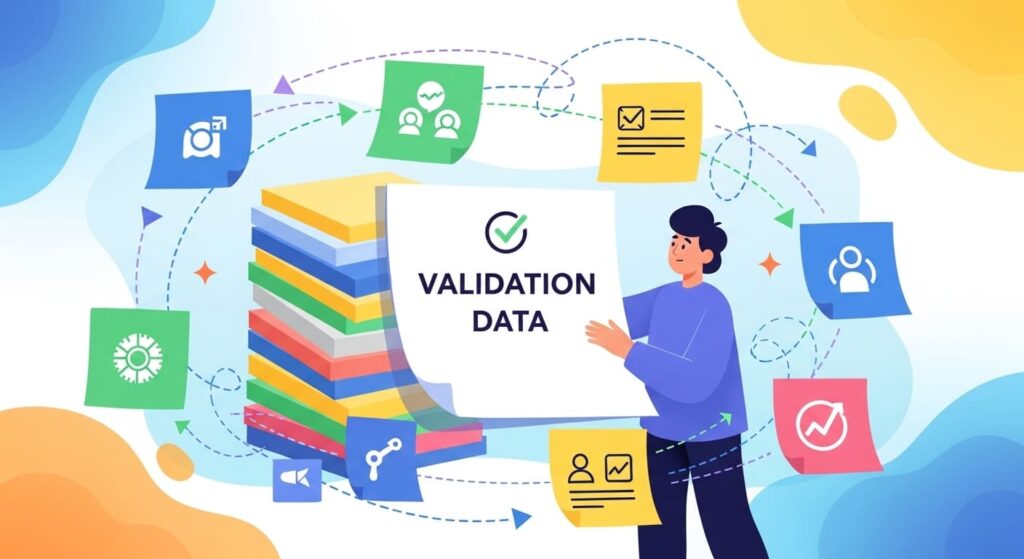
Raw notes are noise. You need structure. With a simple system, you can turn talk into facts that guide real moves. You do not need fancy tools. You need discipline.
Capture words, moments, and measures
During the call, mark exact quotes that sound like pain or value. Put quotes in quotes. These lines will power your deck and your site later. Real words beat clever copy.
Highlight the moments that caused work. These are triggers. “When the light changes, we pause and recheck.” Triggers become product rules and demo beats. They also point to patentable methods if your approach handles them in a new way.
Log counts and times. Even rough numbers help. Minutes lost, parts redone, false alarms per shift. These measures let you size the pain and price the fix. They also make your case studies feel solid.
Code the notes the same day
Right after the call, tag each line. Use a small set of tags like “trigger,” “workaround,” “owner,” “tool,” “metric,” “risk,” “budget.” Do not invent twenty tags. You want to group, not bury. Keep it simple.
Write a one-paragraph summary in plain words. Include the setting, the job, the pain, and the outcome if any. Add one line on next steps. This small digest lets any teammate get the gist in a minute.
Store the notes where the team can see them. Use the same template for every call. Consistency lets patterns jump out. You will spot repeats without a big analysis project.
Roll up patterns into choices
After five to ten calls in one segment, read across the summaries. Count repeats. Which trigger shows up most? Which workaround is common? Which owner has budget? You now have patterns, not guesses.
Turn patterns into choices. If one trigger drives most pain, design your first feature around it. If one role owns the fix, sell to that role first. If one measure is easy to move, make it your promise. This is validation. It moves the roadmap with confidence.
Share the roll-up with your investors in one page. Use three plain lines and one simple chart. This shows you learn fast and act. It also makes your next raise easier because your story rests on field truth.
Measure Signal, Not Noise
Interviews create a lot of words. Your job is to keep the few that matter. Signal is what helps you decide. Noise is everything else. A simple frame keeps you honest and fast.
Separate facts from opinions
Mark facts as things that happened at a time and place. “We paused line 2 for forty minutes on Tuesday.” That is a fact. Opinions sound like “we often slow down.” Facts help you size the pain and plan fixes. Opinions can point you to facts, but do not treat them as proof.
When someone gives an opinion, ask for the last time it happened. This shifts the talk back to facts. You will hear the who, where, and when. These anchors make the note useful. Later, you can turn it into a case that a buyer and an investor both trust.
Keep a small tally of facts per interview. If you end a call with two or three strong facts, that is a win. You do not need twenty. You need a few that tie to the decision you named at the start.
Rank pain by size and frequency
Two axes make pain clear: how big each hit is, and how often it hits. A rare, huge outage may rank below a common, steady drag. Ask for both the size and the count. “How long?” and “How many times last week?” are the simple keys.
Place pains in a tiny grid after the call. Big and frequent goes in the top right. Small and rare goes in the bottom left. The grid is not art. It is a quick way to choose what to fix first. It also gives you a crisp story for your next update.
Share the grid with your team. Ask if anyone has data to confirm the counts. If a log can back it up, pull it. Each confirm lifts trust. Over time, you will build a library of pains with proof, not guesses.
Tie each pain to a clear owner
A pain without an owner stalls. Ask who feels it and who can approve a fix. These are often different people. Both matter. The user who hurts will push. The budget owner will sign. You need both to move fast.
Write down the owner’s title and the budget line if they know it. This turns a vague “we might buy later” into “this team has a path to pay.” In sales, this is gold. In product, it helps you design for the person who can say yes.
If no one owns the pain, treat it as lower rank. You can still help, but do not bet your next month on it. Spend time where a clear owner and a clear budget exist. That is how you turn interviews into income.
Turn Interviews Into Testable Metrics
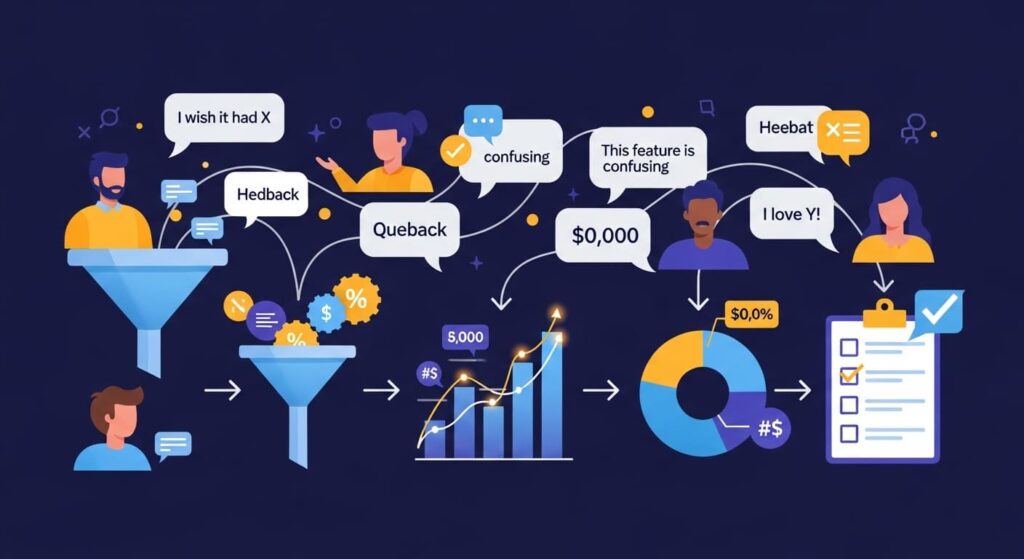
Words become stronger when they link to a number you can watch. Interviews give you the shape of the metric and the first target. Then you can run small tests and learn fast.
Define the moment you will measure
Pick one action that shows value. In a lab, it might be “first clean spec exported.” On a line, it might be “first good part after swap.” This moment should map to the job to be done, not a click in your UI.
Write the moment in one short line and place it in your product review. Your team should see it every week. If the moment changes as you learn, update it and note why. This note becomes part of your story later.
Use the same moment in sales. Promise to help users reach it fast. Then track how long it really takes. Your interview notes told you what blocks it. Your product should remove those blocks one by one.
Set a starter target from field truth
When a user says “changeovers cost us thirty minutes,” set your first target at half. It is bold but within sight. If a buyer says “we re-teach three times a week,” aim to cut that in half too. Interviews gave you the base. The target gives you the mark.
Be open about where the number came from. Say “we heard this in six calls; we will publish logs next month.” Honesty invites help. A partner may offer data to tighten the base. An investor may offer a contact to verify the count.
As you collect real usage, replace estimates with logs. Show the before and after on one chart. Put the interview quote above it. This link—words to numbers—is rare and powerful at pre-seed.
Build tiny loops to learn
For each metric, define one weekly move to try. A new preset. A safer fallback. A clearer label. Small changes teach best. They show cause and effect. The interview told you where to push. Now push there.
Track the change and the result on the same page. If it worked, keep it and move to the next block. If it did not, revert and try the next idea. This rhythm keeps your team focused on the work that moves the metric.
Share the loop in your founder update. “Users said X, we shipped Y, the number moved Z.” Three short lines. This makes your learning visible. It also primes warm intros, because readers see a team that turns talk into traction.
Use Interviews to Shape Early Pricing
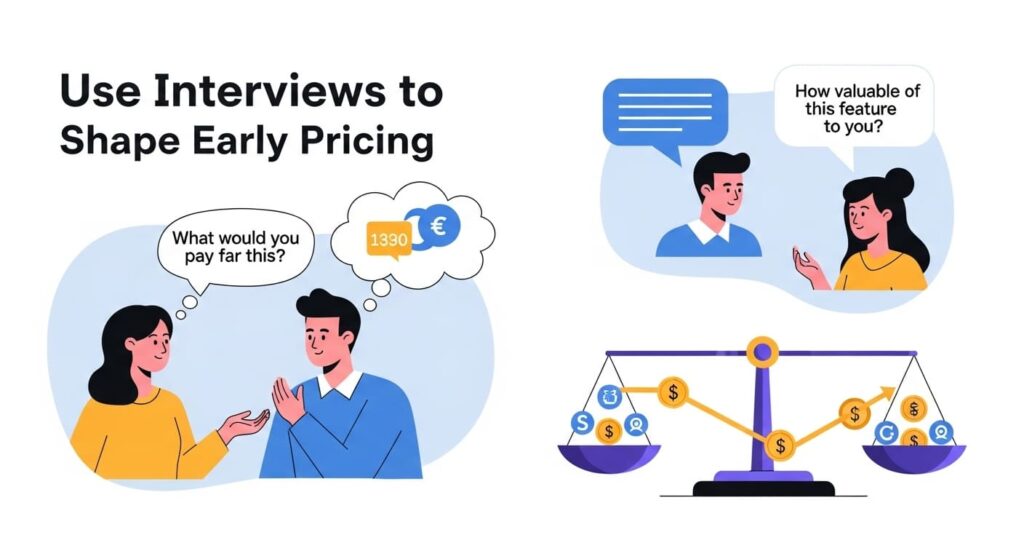
Price is where value and trust meet. Interviews show both. They reveal the outcome people care about and the budget range that feels fair. Use that to test a clean, small offer.
Anchor price to a pain with numbers
Ask what a delay costs. Ask what scrap costs. Ask who sees those costs and when. You are not digging for secrets. You are learning the unit that makes sense. Per run, per line, per shift—pick the unit the buyer already tracks.
Turn the pain into a one-line price. “It’s $X per line per month to cut Y by half.” Keep the scope small so the risk feels low. The clearer the unit, the faster the answer. Ambiguity slows deals and breeds discounts.
When you get pushback, ask which part feels off: the unit, the scope, or the amount. This tells you what to test next. You do not need a perfect model. You need the next clean step toward it.
Offer a paid first step that matches approval paths
Interviews tell you who can say yes and how. If a plant manager can sign a small PO, shape your pilot around that level. If a lab lead can swipe a card, price the first run to that card. You are not selling the whole future. You are selling a short, safe step.
Tie the step to one metric from the interview. Promise to report it weekly with a screenshot. This turns your price into a promise. It also keeps the pilot tight so it does not drift into free work.
At the end of the pilot, anchor the next step to the same unit. If the outcome was real, the path to a larger plan will be clear. Your note will write itself because the user gave you the words.
Learn the ceiling and floor without drama
Ask about budget ranges and thresholds in plain terms. “What would be easy to approve?” “What would need a longer review?” Buyers will tell you, especially if you already helped them in the pilot.
Keep your raises gentle. If three buyers said yes fast, try a small increase on the next one. Watch the pace and the tone. A fast yes may mean room to move. A slow maybe means your story or scope needs work.
Write down the moments that unlocked approval: a safety proof, a clean security packet, a clear ROI note. These become parts of your standard offer. Each one lifts trust and price with less friction.
Feed Your Go-To-Market With Real Stories
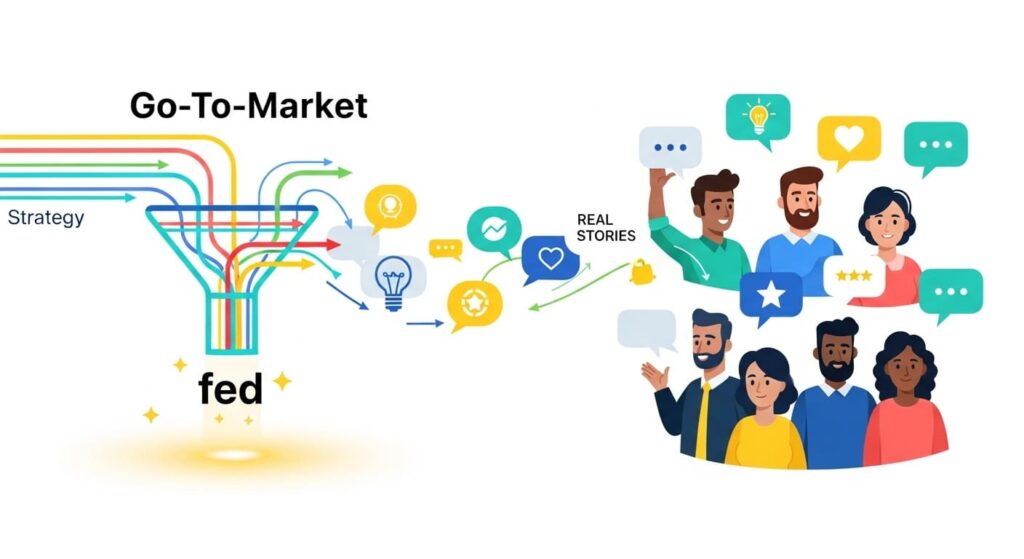
Interviews give you scenes and lines that sell. They also help you focus your outreach. Use the words you heard. Show the screens they use. Keep it specific and short.
Rewrite your pitch in the customer’s language
Swap your terms for theirs. If they say “re-teach,” you say “re-teach.” If they say “batch,” you say “batch.” This creates instant trust. People hear their world and lean in.
Open with a real scene you heard. “On Monday’s swap, glare forced a pause.” Then show how your tool handles that scene. This beats a generic demo because it feels like today, not someday.
Close with the metric they care about. Use the number from the interview. Promise how fast you will move it. Tie the promise to your small, paid step. The arc is now tight: scene, fix, proof, step.
Aim outreach at lookalikes
Tag your interview notes with the line type, device type, and role. Build a short list of lookalike accounts. Ask for intros to those exact roles. Mention the scene from your note. Specifics open doors.
Run short, focused campaigns. Ten good messages beat a hundred vague ones. Each reply will sound like your interview. You will know the answers because you already heard them.
Log which scenes resonate most. Those become your top-of-funnel hooks. Keep them real. Update them quarterly. Your pipeline will feel warmer because it is built from truth.
Build assets straight from the field
Turn one interview into a one-page story. Use the user’s words. Add a small chart. Keep the file light and easy to forward. This is not a glossy case study. It is a proof note.
Record a two-minute walkthrough that shows the exact fix. No music. No fluff. Just clicks and results. Save it in your data room and share it in calls. Busy buyers and VCs both love short, real clips.
Review these assets each month. Replace old scenes with newer, tighter ones. Over time, you will have a small library that sells better than any long deck.
Aim Interviews at Your IP Strategy

User stories reveal the methods that matter. When the same tricky moment shows up, and your approach handles it in a new way, that is a sign. It may be worth a filing. Protecting it early keeps your edge.
Spot repeatable, novel methods in the flow
Listen for triggers that break other tools. Glare, drift, occlusion, noisy labels—these are rich seams. If your pipeline or control loop handles them in a different way, write it down step by step.
Map inputs to outputs. What signals go in, what transforms happen, and what guardrails keep it safe? Interviews give context that proves why the method matters. Patents need both novelty and utility. Field scenes make the utility clear.
If the method shows up in three or more interviews and drives a key metric, elevate it. That is not a feature. That is the engine. Engines are what you protect.
Draft claims in plain words first
Write the method like a recipe. Simple steps. No legalese. Share it with your team. Ask if this is the thing that makes results fast, safe, or cheap. If yes, this is your core claim idea.
Layer in variations you heard in the field. Different sensors, different layouts, different noise. Cover the set without getting lost. Your goal is breadth with clarity, not a maze of edge cases.
Save the interview quotes that prove utility. “We kept speed with glare present.” These lines, paired with your method map, make your provisional stronger and your story tighter in the room.
File fast, then refine with use
Start with a focused provisional. Plant a flag on the engine. As you deploy, gather logs and refine claims. Your interviews will guide which versions matter most in real sites.
Align roadmap to protected loops. When your best value is also your protected value, copycats fall behind even if they see your surface. This is how small teams hold ground.
Tran.vc works side by side on this. We invest up to $50,000 in in-kind patent and IP services so your interview-backed methods become real assets. If that fits your plan, apply at https://www.tran.vc/apply-now-form/.
Avoid Bias and Common Pitfalls
Interviews go wrong in quiet ways. Bias creeps in. Hype sneaks in. A few guardrails keep your data clean and your moves sharp.
Do not lead the witness
Avoid questions that hint at your desired answer. “Wouldn’t it be great if…” is poison. Ask open, past-tense questions. Let the user choose words. Your job is to learn, not to win the call.
If someone starts praising your idea, steer back to their last day at work. Compliments feel good but teach little. Facts about yesterday teach a lot. Be kind and firm.
If you slip, correct it out loud. “Let me ask that a better way.” This resets the tone and shows respect. People will follow your lead back to truth.
Watch selection and confirmation bias
If all your interviews come from friends, you will hear friendly things. Mix sources. Add a few cold contacts. Add a partner’s client. Diversity of input protects you from false confidence.
Check your own notes for patterns you want to see. Then look for the opposite. If you think glare is the top trigger, ask about shifts without glare. If the pain still shows up, your engine may be elsewhere.
Have a teammate code a few calls blind. Compare tags. If they differ, tighten your tag rules. Small calibration steps keep your dataset usable as you scale.
Keep ethical lines clear
Say how you handle data and privacy. Keep sensitive details out of public docs. Redact names in assets unless you have written permission. Trust takes months to gain and minutes to lose.
If a user asks you to keep a part off the record, honor it. The long game matters. Word travels in tight industries. Your name should mean care and clarity.
When your product touches safety, be extra careful. Never overstate what it can do. Show confidence scores. Provide safe fallbacks. Your interviews will show buyers that you take this seriously. That is how deals close in the real world.
Build an Interview Cadence
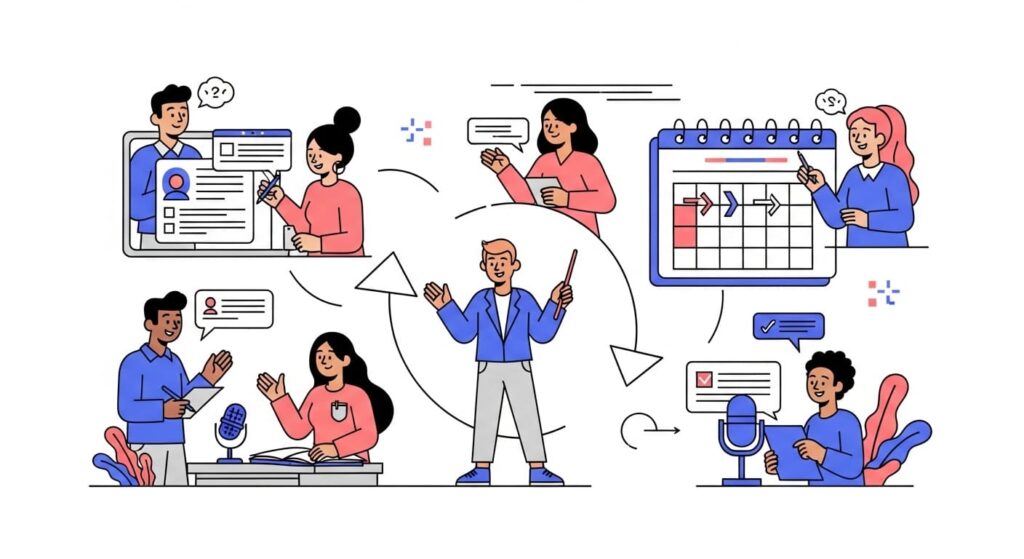
Interviews work best when they are a habit, not a burst. A steady pace keeps your view fresh, your pipeline warm, and your roadmap grounded. Treat this like a core process, the same way you treat builds and releases.
Set a weekly rhythm
Pick a fixed day and time window for calls. Guard it on the calendar. A small, repeatable block beats a scramble each week. When time is fixed, recruiting gets easier and your team shows up prepared.
Aim for a modest count you can sustain. Two to four calls a week is plenty for most pre-seed teams. Depth matters more than volume. With this pace, notes get coded the same day and insights land in the next sprint.
Hold a short debrief right after the last call. Ten minutes is enough. Name one new fact, one repeated pattern, and one action. Log them in the same place every time. This turns talk into motion without delay.
Keep a simple source map
Know where each interview came from. Tag intros from friends, partners, customers, and cold outreach. Over time, you will see which sources bring the clearest truth and the fastest follow-ups.
Note the segment and setting in a single line at the top of each note. Include role, environment, and tool stack. This line helps you filter later when you craft a focused offer for one wedge.
Refresh the map monthly. Add channels that worked and pause ones that did not. This keeps your funnel of interviewees healthy, and it mirrors how you will later manage sales pipeline.
Close the loop with participants
Send a short thank-you the same day. Include one thing you learned and one move you will make. People like to see impact from their time. It builds trust and opens doors for future tests.
When you ship a change based on their input, tell them. A single screenshot with a one-line note is enough. Many will share it with peers, which brings you more voices that match your target.
Invite a few to try a tiny pilot if it fits. Keep the step small and safe. Make it easy to say yes. Interviews often become your first paid wins when you honor the loop and move fast on what you heard.
Train Your Team to Interview Well
Great interviews are a team sport. Founders set the tone, but engineers, designers, and GTM teammates should all learn the craft. Shared skill speeds learning and keeps bias low.
Assign clear roles in the call
Have one person lead, one person probe, and one person take notes. Rotate roles over time so everyone builds muscle. When roles are clear, the call flows and no key detail gets lost.
The leader keeps time and guides the arc from opener to close. The probe asks short follow-ups like “what happened next?” and “how long did that take?” The note-taker captures quotes, steps, and measures in your shared template.
After the call, each person shares one insight from their seat. Engineers notice steps and tools. Designers hear language and emotion. GTM hears owners and budget cues. Together, the view becomes sharp.
Practice on safe ground
Run a few dry interviews inside your network before talking to strangers. Ask a friendly plant manager or a lab lead you know to role-play a real day. Record it, then review as a team.
Listen for leading questions and vague prompts. Rewrite them in plain, past-tense form. Tighten transitions between topics. Fix small habits like stacking questions or interrupting stories.
Repeat until the rhythm feels calm and clean. Ten minutes of practice pays back many hours later. When the stakes are real, your team will sound natural and earn trust fast.
Coach with real examples
Build a small library of good and bad clips. Mark the moments where a strong follow-up unlocked truth, and the moments where a weak prompt caused drift. Keep the clips short.
Use these clips in onboarding for new teammates. A few minutes of real audio teaches more than long docs. People learn tone, timing, and restraint by hearing it.
Refresh the library each quarter with your latest wins. As your product and market evolve, so will the questions that matter. Your training should evolve at the same pace.
Turn Interviews Into Roadmap and Sprints

Interviews pay off when they change what you build next. The path from quote to commit should be short and clear. Make this handoff a ritual so insights never die in docs.
Create a “field-backed” ticket type
Add a tag in your tracker that marks tickets supported by interviews. Link the exact notes and quotes. This gives weight to work that solves a proven pain and keeps debates focused.
Require a single-sentence user story in the user’s words. “When glare flips, I have to re-teach and lose thirty minutes.” This keeps the team aligned on the job, not the interface.
During sprint planning, pick at least one field-backed ticket each cycle. Ship it, measure the metric it targets, and report the change in your next founder update. Over time, this drumbeat becomes your brand.
Design with the real scene in mind
When you sketch, put the actual tools and screens from the interview on the page. Show where your system sits in the flow. Draw the trigger that starts the job and the guardrail that keeps it safe.
Use the user’s labels. If their screen says “Batch ID,” yours should too unless you have a strong reason to differ. Small language matches cut confusion and time-to-value.
Before you ship, sanity-check the design with the interviewee if possible. A five-minute look can prevent a week of rework. People will point out missing steps you did not see.
Measure the outcome you promised
Each field-backed ticket should tie to a metric from the same interview set. Cut time, reduce re-teach, improve yield—pick one. Add lightweight logging to capture the effect.
Share the before and after in a short internal note. Include one screenshot and one line from the original interview. This keeps morale high and keeps the roadmap centered on impact.
If the metric did not move, say so and adjust. Interviews guide you, but reality rules. The goal is honest loops that raise the floor, not perfect predictions.
Use Interviews in Fundraising and Sales
Words from the field make your story real. When you show numbers alongside quotes, partners stop guessing. They can see value, speed, and a path to scale.
Build one “voice of the customer” slide
Put three short quotes at the top, each tied to a metric and a role. Keep them in the speaker’s language. Beneath each, place a tiny chart that shows the related shift after your change.
End the slide with one sentence that ties the three into a theme. “We cut setup pain that kept lines idle.” This single slide is often the one people remember after the meeting.
Use the same slide in sales with role-specific versions. Swap quotes and charts based on who is in the room. You are not changing your story; you are speaking their dialect.
Tell one clean before-and-after story
Pick a single scene from an interview and walk it like a film: setup, trigger, action, result. Then show your product handling the same scene with fewer steps and safer outcomes.
Keep the timing tight. Aim for two minutes end-to-end. This makes it easy to share inside a buyer’s org and inside an investor’s partnership. Short stories travel.
Close with the small, paid next step that matches the scene. The path from story to action should feel natural. Your interview already named the metric and the owner. Use them.
Answer objections with field proof
When someone pushes on safety, show the clip where the system slowed on drift. When they push on data needs, show the case that worked with small, noisy sets. Interviews become your shield.
Keep a private index of quotes and clips by objection type. In calls, you can pull the right proof in seconds. This turns debate into review of real scenes.
Update the index as new themes appear. As you scale, your proof stack will grow. It will save time, win trust, and cut stalls in both sales and raises.
Turn Interview Insights Into Repeatable Offers
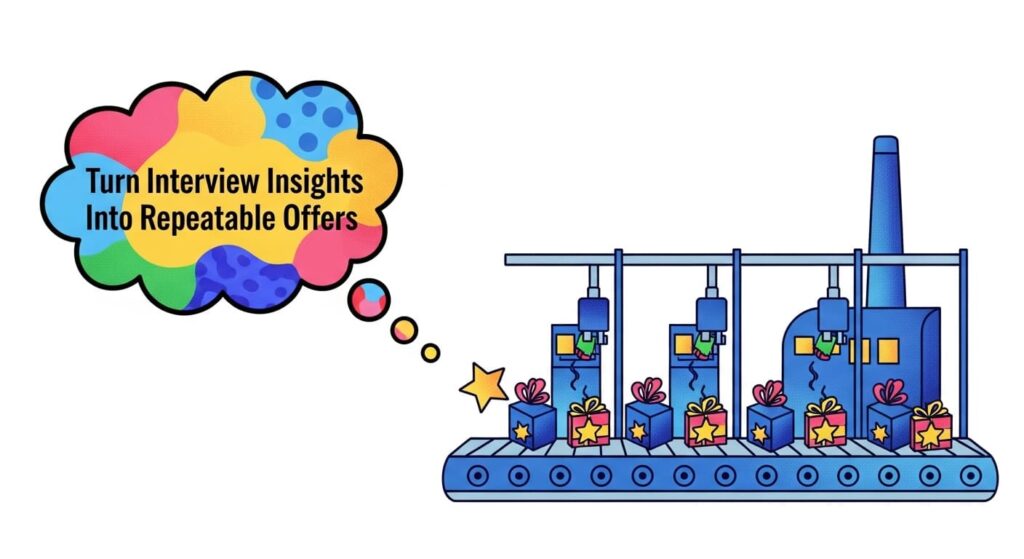
A repeatable offer is a small product and service bundle that maps to one clear job. Interviews give you the parts. Package them so buyers can say yes fast and your team can deliver without heroics.
Define the job, the result, and the clock
State the job in plain words, the measurable outcome, and the time to first win. Keep the scope narrow enough to fit the approval path you learned in interviews.
Write the promise like a line on a ticket. “Cut re-teach events by half on line 3 in two weeks.” This keeps everyone aligned and sets a fair, firm bar.
Make the offer easy to send as a one-pager. Busy buyers forward what is simple. Your interviews already gave you the proof and the language. Now you are just binding them.
List only the steps that matter
From your interview notes, choose the few steps that actually drive the result. Remove anything that adds time without adding trust. Each extra step is a chance for drift.
Assign owners for each step on both sides. Interviews told you who holds which keys. Put names on the page, not job families. Clear owners prevent stalls.
Include your safety rails. Buyers want to see how you avoid harm and recover fast. Your interviews on edge cases supply the right details without spooking the room.
Price and terms that match reality
Use the unit, range, and threshold you heard during interviews. Keep the price simple. Offer a small, paid start and a clean path to expand if the result shows up.
Keep legal light with a short order and clear data use. Your security packet should answer common questions without a meeting. Interviews told you which questions matter most.
As you deliver, capture new quotes and measures. Fold them back into the offer. Every run makes the next run faster because the package now mirrors the field even more closely.
Conclusion
Strong interviews turn talk into truth. They show real moments, real costs, and real owners. When you code those notes the same day, pick the metrics that matter, and run tiny tests, you turn stories into proof. That proof guides what to build, how to price, who to target, and which risks to remove. It also gives you clean lines for your pitch—short quotes, simple numbers, and a calm plan that anyone can repeat.
Keep the loop tight. Set a goal, meet the right people, ask about the last time, and close with one clear next step. Ship a small change, measure the result, and send a short update. Protect the method that makes the result possible so the edge stays yours. Over a few weeks, your interviews will shape a focused offer, faster cycles, and a quiet moat that rivals cannot copy.
If you want a hands-on partner for this work, Tran.vc invests up to $50,000 in in-kind patent and IP services for AI, robotics, and deep tech teams. We help you turn interview insights into protected methods and a fundable story you can stand on. If that’s your next step, apply now at https://www.tran.vc/apply-now-form/.
